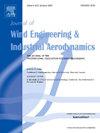建筑物侧壁前缘涡改造过程中的强吸力事件
IF 4.9
2区 工程技术
Q1 ENGINEERING, CIVIL
Journal of Wind Engineering and Industrial Aerodynamics
Pub Date : 2025-07-22
DOI:10.1016/j.jweia.2025.106180
引用次数: 0
摘要
在Silsoe 6 m立方体侧壁的压力测量显示最小压力系数明显低于准稳态理论的预期。利用速度和压力数据说明,这可能与前缘涡在风向变化时的改变有关。中高度的速度数据显示,随着LEV的增加,流动方向逐渐逆转,最强烈的反转流发生在更迎风的位置,持续时间较短,强度超过平均观测值的两倍以上。同样,随着LEV的发展,压力也呈现出吸力顺序增加的模式,峰值通常出现在迎风水龙头处。由于来自远程桅杆的参考数据无法提供与短时间事件相关的足够准确的信息,因此使用迎风面上两个水龙头的压力来提供对风动压力和风向的局部估计。条件平均用于突出显示与压力峰值相关的潜在模式。这显示了一个清晰的模式,即在迎风边缘附近发生强烈的吸力,然后随着LEV的发展和在侧壁表面的扩散而减弱。本文章由计算机程序翻译,如有差异,请以英文原文为准。
Strong suction events during reformation of leading-edge vortices on building side walls
Pressure measurements on the side walls of the Silsoe 6 m Cube exhibited minimum pressure coefficients which were significantly lower than expected from quasi-steady theory. Both velocity and pressure data are used to illustrated that this can be associated with the reformation of the Leading-Edge Vortex (LEV) as the wind direction changes. Velocity data at mid-height showed the progressive reversal of flow direction as the LEV grew, with the strongest reversed flows occurring at the more windward location for a short duration with a magnitude more than twice that which might be expected from the mean observations. Similarly, the pressures exhibited a pattern of sequential increase in suction as the LEV developed, with the highest peak usually occurring at the windward tap. Pressures from two of the taps on the windward face are used to provide a local estimate of the wind dynamic pressure and wind direction, since reference data from a remote mast fails to give sufficiently accurate information to relate to short duration events. Conditional averaging is used to highlight the underlying patterns associate with the pressure spikes. This shows a clear pattern of strong suctions occurring near the windward edge and then weakening as the LEV develops and spreads across the face of the sidewall.
求助全文
通过发布文献求助,成功后即可免费获取论文全文。
去求助
来源期刊
CiteScore
8.90
自引率
22.90%
发文量
306
审稿时长
4.4 months
期刊介绍:
The objective of the journal is to provide a means for the publication and interchange of information, on an international basis, on all those aspects of wind engineering that are included in the activities of the International Association for Wind Engineering http://www.iawe.org/. These are: social and economic impact of wind effects; wind characteristics and structure, local wind environments, wind loads and structural response, diffusion, pollutant dispersion and matter transport, wind effects on building heat loss and ventilation, wind effects on transport systems, aerodynamic aspects of wind energy generation, and codification of wind effects.
Papers on these subjects describing full-scale measurements, wind-tunnel simulation studies, computational or theoretical methods are published, as well as papers dealing with the development of techniques and apparatus for wind engineering experiments.

 求助内容:
求助内容: 应助结果提醒方式:
应助结果提醒方式:


